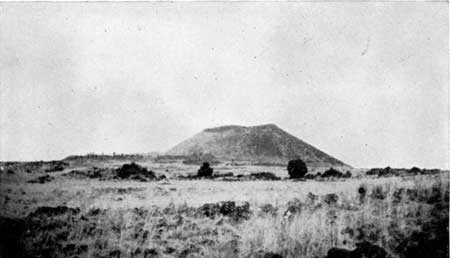![]()
MENU
|
Glimpses of Our National Monuments CAPULIN MOUNTAIN NATIONAL MONUMENT |

Capulin Mountain.
Capulin Mountain, N. Mex., is a magnificent example of a recently extinct volcano. Rising to an altitude of about 8,000 feet above sea level, it stands 1,500 feet above the general level of the surrounding plain. It is a steep-sided, circular cinder cone having a well-marked crater at its summit, with a broad platform at its base built up by successive flows of lava. The mountain is about a mile and a half in diameter at its base. The diameter of the crater from rim to rim is about 1,500 feet and its bottom is about 75 feet below the lowest part of the rim and 275 feet lower than the highest point.
Capulin Mountain is situated in the center of a volcanic region whose western extremity is about 50 miles east of the Rocky Mountains and which extends easterly from Raton Pass on the Santa Fe Trail through southern Colorado and northeastern New Mexico into Oklahoma, a distance of more than 80 miles. Evidence of the tremendous volcanic activity that occurred in this section is to-day disclosed in the mesas built up by layers of successive lava flows of varying thicknesses, separated by long periods of time, and now exposed through the action of erosion. Great cracks in the earth through which the molten rock poured forth are exposed in the eroded areas as dikes of solidified lava. In some places where the lava welled in through relatively small pipes the hardened filling flow protrudes from the surface as "plugs," the softer rock around them having been eroded away. In other places the lava issued through vents, and mountains were built up. The cinder cones represented by Capulin Mountain were the last to be formed and result from the last relatively feeble effort of the dying volcanic forces.
The national monument, created by presidential proclamation August 9, 1916, covers an area of 680.37 acres. Its principal exhibit, Capulin Mountain, is one of the striking features of this region of unique and attractive scenery. It is 6 miles southwest of Folsom, N. Mex., on the Colorado Southern Railroad, and 3 miles north of the town of Capulin, on a branch line of the Santa Fe system. The Colorado-to-Gulf Highway passes south of the monument through Des Moines and Capulin Station, and another road passes east of the monument through Des Moines and Folsom. Autos can be driven from the base of the volcano to the rim of the crater over a well-packed cinder road built by the National Park Service. The road is approximately 2 miles in length and 15 feet wide and has a 6 per cent grade. Homer J. Farr, the custodian of the monument, lives at the town of Capulin.
|
|
Last Modified: Thurs, Oct 19 2000 10:00:00 pm PDT
glimpses2/glimpses3.htm

 Top
Top